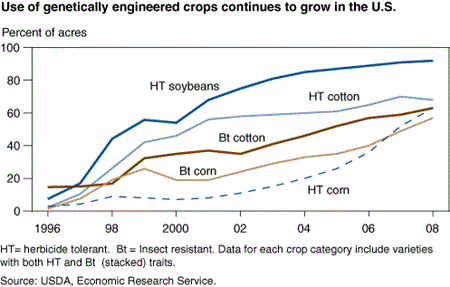Rapid Growth in Adoption of Genetically Engineered Crops Continues in U.S.

U.S. farmers have rapidly adopted genetically engineered (GE) soybeans, cotton, and corn with herbicide tolerance and/or insect resistance traits over the 13 years since their commercial introduction. According to ERS research, U.S. farmers are realizing economic benefits from GE crops, including higher yields, lower pesticide costs, and savings in management time. The impacts of GE crops vary with the crop, technology, pest infestation levels, and other factors.
Herbicide-tolerant (HT) crops are treated with certain effective herbicides, allowing adopters of these varieties to control pervasive weeds more effectively. In the U.S., HT soybean adoption has expanded more rapidly and widely than other GE crops, reaching 92 percent of planted soybean acreage in 2008. The second most adopted variety, HT cotton, was planted on 68 percent of cotton acreage. The level of HT corn adoption, which had been modest in earlier years, has recently accelerated, reaching 63 percent of U.S. corn acreage.
Insect-resistant (Bt) crops contain a gene from the soil bacterium Bacillus thuringiensis that produces a protein toxic to specific insects. Bt cotton, which controls tobacco budworm, bollworm, and pink bollworm, was planted on 63 percent of U.S. cotton acreage in 2008. Adoption of Bt corn plateaued in the U.S. during 1998-2002 because farmers who needed to protect their crops against the European corn borer had already adopted it. However, adoption of Bt corn is increasing again since a Bt variety to control corn rootworm was introduced in 2003. Bt corn was planted on 57 percent of U.S. corn acreage in 2008.
The rapid increase in the adoption of crop varieties with more than one GE trait (stacked traits) continues. Corn varieties with both Bt and HT traits grew from 1 percent of corn-planted acres in 2000 to 40 percent in 2008, while cotton varieties with stacked traits increased from 20 to 45 percent of cotton-planted acres in the same period.
In addition to corn, soybeans, and cotton, U.S. farmers have adopted HT canola and virus-resistant papaya and squash. Moreover, other GE crops are in various stages of development. As of May 2008, USDA’s Animal and Plant Health Inspection Service had approved 1,311 field-testing applications for crops with resistance to virus, 842 for resistance to fungi, 2,200 for improved agronomic properties (such as resistance to cold, drought, and salinity), and 3,362 for higher product quality (including crops with increased protein and/or oil content, and crops with added vitamins and iron).
Worldwide, more than 280 million acres of GE crops with HT and/or Bt traits were planted in 23 countries in 2007, with the U.S. accounting for about 50 percent. Argentina, Brazil, Canada, India, China, Paraguay, and South Africa accounted for about 49 percent.
Adoption of Genetically Engineered Crops in the U.S., by Laura Dodson, USDA, Economic Research Service, October 2023
The First Decade of Genetically Engineered Crops in the United States, by Jorge Fernandez-Cornejo and Margriet Caswell, USDA, Economic Research Service, April 2006


